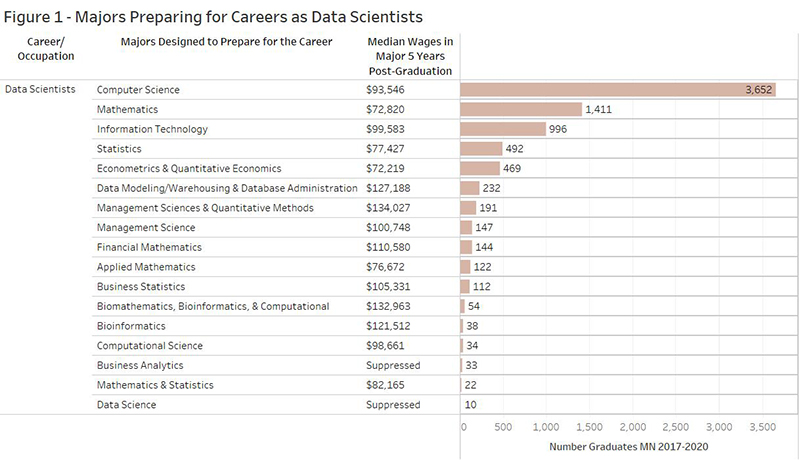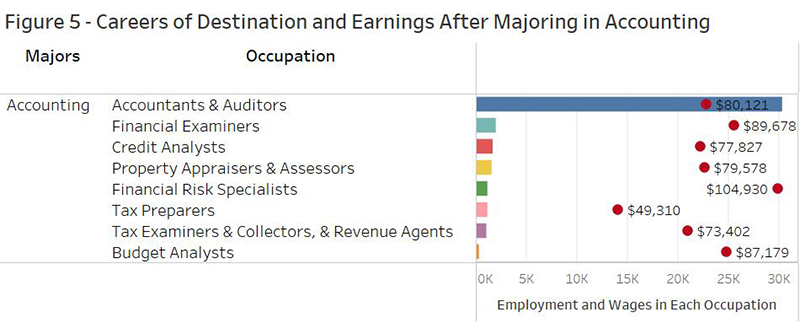
by Alessia Leibert
March 2025
DEED's new College Major to Career Connector tool allows students, counselors and educational planners to search for majors starting from a career of interest and, vice-versa, to explore the full range of careers a specific major can prepare graduates for.
These two functionalities correspond to two tabs:
Interactive filters allow users to slice the data by 563 majors and connect them to 505 occupations.
Understanding how majors relate to careers is helpful to high school students deciding on a college major. It can also help recent graduates explore the most typical career paths that could be open to them after completing a specific major.
The following four use case scenarios demonstrate the uses of the tool.
CASE 1: Laura, a high school senior, is interested in exploring what majors can prepare her for a career as a Data Scientist. She enters "data scientist" in the Search by Keyword filter and obtains the results shown in Figure 1.

The 17 horizontal bars represent all majors designed to prepare for work as a Data Scientist. This career has become so popular that a new major, called Data Science, was recently added to program offerings in Minnesota. We find it at the very bottom of the chart because it had only 10 graduates in our study period (2017-2020).
All 17 fields are quantitative in nature and span a wide variety of disciplines from economics to business analytics. The first major on the list, Computer Science, is the most popular with students, accounting for 3,652 graduates from 2017 to 2020. Earnings five years after graduation were very high, $93,546 at the median.
Although we can't tell how many Computer Science graduates actually applied for, and were hired in, jobs as Data Scientist, Laura understands that the potential labor pool qualified to take entry-level jobs in this occupation comes predominantly from Computer Science programs.
By hovering over the horizontal bar, she can see the distribution of these graduates by degree level: 82% of Computer Science graduates completed a bachelor's degree, 11% a graduate certificate or degree and only 7% an associate degree. Other majors on this list sound interesting to Laura and have high earnings. She can use this list as a starting point for comparing different educational options to prepare for her dream career.
CASE 2: Mark, a high school graduate taking a gap year to explore college and career options, is interested in finding out whether a postsecondary credential can help him become a professional photographer. He types "photographer" in the search box and obtains the results shown in Figure 2.

Four majors offered in Minnesota can prepare for work as a Photographer. The top one in terms of size is Art/Art Studies with 678 recent graduates, but this major looks loosely related to photography. Smaller majors, Photography and Commercial Photography, are a better fit for Mark's career goals. However, he notices relatively lower earnings among Photography graduates: $34,299, below the Minnesota living wage1.
By hovering over the bars, Mark also discovers that a high share of graduates in Photography (47%) earned a bachelor's degree, while most graduates in Commercial Photography (51%) earned a short-term certificate. Mark finds it surprising that Commercial Photography graduates, despite having less education overall than Photography graduates, earned higher wages. Although it is possible that a four-year degree in Photography can open the door to better jobs, bachelor's graduates might be over-qualified for the types of job opportunities available in the Minnesota labor market for Photographers.
Mark uses the Education Most Commonly Required for The Career filter to discover, indeed, that the most common education requirement for Photographers is high school diploma or less. This is true for most occupations in the Arts, Design, Entertainment, Sports & Media family.
In light of this evidence, Mark could rethink his choice of major or opt for a major like Commercial Photography, where graduates from shorter, more affordable programs attained higher wages than Photography graduates.
This example demonstrates how the tool can help users decide on a major as well as on the level of education sufficient to be competitive in the job market. It can also help postsecondary educational planners evaluate the alignment between the amount of education students obtain and the level required for entry into an occupation.
CASE 3: Sheila, a high school senior, is interested in exploring what majors can prepare her for a career as a Mechanical Engineer. She selects "Architecture & Engineering" from the Select Career Group filter, then checks the box corresponding to "Mechanical Engineer". The results of this selection are shown in Figure 3.

Unlike Data Scientists and Photographers, the occupation of Mechanical Engineers matches only one major: Mechanical Engineering. By hovering over the horizontal bar, Sheila discovers that this major exists only at the Bachelor's and graduate levels.
Majors that lead to only one career of destination can be risky unless that career is in high demand or employs a sizeable number of people. Sheila would like to know if Mechanical Engineers are in demand in Minnesota. She clicks on the "From Major to Careers" to open up the second tab, where she types "Mechanical Engineering" in the search field. The results of her search are displayed in Figure 4.

This major can prepare for three careers besides Mechanical Engineers: Cost Estimators, Engineering Managers, and Aerospace Engineers, shown as horizontal bars. The occupation of Mechanical Engineers is the largest, employing 5,660 individuals in Minnesota, indicating better employment opportunities than the other three occupations. Hovering over the horizontal bars for each occupation, Sheila discovers that Mechanical Engineers have the highest demand score (5), while Engineering Managers and Cost Estimators have a score of 4.
Earnings are also important to consider when picking a major, because they can give Sheila an idea of the approximate time it might take for her to repay her student loans. From the first tab (Figure 3) she learns that graduates earned $92,137 in the fifth year after finishing this major. From the second tab (Figure 4) she learns that Mechanical Engineers in Minnesota, regardless of age, earn median wages of $97,375 per year. The similarity between these two earnings measures suggests that Mechanical Engineering graduates landed jobs as Mechanical Engineers or other roles aligned with what they studied in the classroom.
Therefore, in terms of employment size, demand, choice of careers of destination and earnings, this major appears to be a solid choice to Sheila.
CASE 4: Colin is working towards an associate degree in Accounting and would like to know which types of jobs he can apply for that require his credential. Starting from the "From Major to Careers" tab, he types "Accounting" in the keyword search box. The results of this selection are shown in Figure 5.

There are eight careers of destination for his major, some of which Colin had never considered as potential career paths. Hovering over the horizontal bars, he discovers that the most common education requirements for Accountants and Auditors, his target occupation, is a bachelor's degree. Only Tax Preparers and Property Appraisers & Assessors require less than a bachelor's degree. Seeing higher wages and higher demand for Accountants and Auditors reinforces Colin's interest in these careers, but he wonders whether he should try to transfer to a four-year degree program. He also discovers from the tool's first tab that only 19% of Minnesota graduates stop at an associate degree in his major, suggesting that he would be competing with many bachelor's degree holders for Accounting jobs.
Colin decides to use another tool, the College Major to Industry tool, to gather more evidence that can help him decide. Comparing the earnings outcomes and industries of employment of bachelor-level Accounting programs with those of associate-level programs can help him determine whether additional education is worth the cost. Were he to decide to stop at an associate degree, he will need to target his job search towards the minority of Accountant job postings that do not requiring a bachelor's degree, or focus on a career as Property Appraiser and Assessor, which pays more and is in higher demand than others requiring vocational training.